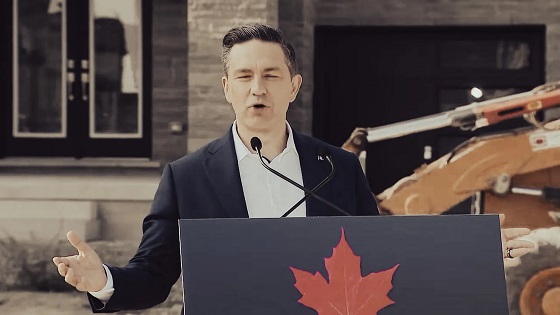Environment
Wall Street’s planned theft of America’s lands and waters

From the Frontier Centre for Public Policy
When we are issued carbon allowances, owners of said lands will be able to claim tax deductions and will be able to sell carbon allowances to businesses, families and townships. In the simplest of terms, that’s where the money will be made. WE peons will be renting air from the richest people on earth.
Everything will be monetized and measured and traded, even you.
Up next on Wall Street’s exploitation list.
If not stopped, on November 17th, the U.S. government will pass a rule that allows for America’s protected lands, including parks and wildlife refuges, to be listed on the N.Y. Stock Exchange. Natural Asset Companies (NACs) will be owned, managed, and traded by companies like BlackRock, Vanguard, and even China.
Since the early 2000’s, outfits like Goldman Sachs have been trying to trade air, or specifically carbon without much success. Their 2005 carbon exchange staggered along until it was quietly discontinued, and their Climate Exchange-Traded Fund (ETF) is now facing delisting. “ESG” was the next attempt to monetize the un-monetizable, with the “E” part of that acronym standing for Environment, ill-defined as that was. Now ESG is failing. Market leaders say it is facing “a perfect storm of negative sentiment” and its U.S. investments fell by $163 billion in the first quarter of 2023 alone.
Its stepchild, Net-Zero, is so loathed, it looks like it might blow up the entire carbon scam. Says Australian senator Matt Canavan, “Net-Zero has absolutely carked it. It is a soundbite and totally insane. Almost everything we grow, we make, we do in our society relies on the use of fossil fuels.” Vanguard has pulled out of Net-Zero funds. The British government too is backing out of Net-Zero, saying “we won’t save the planet by bankrupting the British people.” New Zealand’s new government revised the country’s Net-Zero plans in its first week in office. In the hard hit Netherlands, the Farmer-Citizen movement is now the dominant party in the Dutch senate and every provincial assembly. Sweden has abandoned its 100 percent Net-Zero plans and Norway has announced another $18 billion in oil and gas investments.
Not going to happen.
Even in the submissive E.U. voters are turning from the “green” parties toward anti-E.U. parties. Renewables funds are seeing massive outflows because of rising interest rates and declining subsidies. Of course, the massive subsidies taxpayers have already given both “renewables” investors and “renewables” companies will never be clawed back. All we will get is a shrug as they move onto the next kill. Which is so obvious it is a wonder no one predicted it.
The entire universe envies the lush interior of the U.S. Increasingly empty, it is filled with a cornucopia of minerals, fiber, food, waters, extraordinarily fertile soil as well as well-ordered, educated, mostly docile people. Worth in the quadrillions, if one could monetize and trade it, financialize it, the way the market has financialized the future labor of Americans, well, it would be like golden coins raining from the sky.
On October 4th, the Securities and Exchange Commission filed a proposed rule to create Natural Asset Companies (NACs). A twenty-one day comment period was allowed, which is half the minimum number of days generally required. NACs will allow BlackRock, Bill Gates, and possibly even China to hold the ecosystem rights to the land, water, air, and natural processes of the properties enrolled in NACs. Each NAC will hold “management authority” over the land. When we are issued carbon allowances, owners of said lands will be able to claim tax deductions and will be able to sell carbon allowances to businesses, families and townships. In the simplest of terms, that’s where the money will be made. WE peons will be renting air from the richest people on earth.
The following are eligible for NACs: National Parks, National Wildlife Refuges, Wilderness Areas, Areas of Critical Environmental Concern, Conservation Areas on Private and Federal Lands, Endangered Species Critical Habitat, and the Conservation Reserve Program. Lest you think that any conserved land is conserved in your name, the largest Conservation organization in the U.S., is called The Nature Conservancy, or TNC, which, while being a 501(c)3, also holds six billion dollars of land on its books. Those lands have been taken using your money via donations and government grants, and transferred to the Nature Conservancy, which can do with those lands what it wills.
If this rule passes, America’s conserved lands and parks will move onto the balance sheets of the richest people in the world. Management of those lands will be decided by them and their operations, to say the least, will be opaque.
μολὼν λαβέ, buddy.
Farm country is fighting back. American Stewards of Liberty, Committee for a Constructive Tomorrow, Kansas Natural Resource Coalition, Financial Fairness Alliance and Blue Ribbon Coalition have filed comments, Republican senators Pete Ricketts, James Risch and Mike Crapo have sent pointed queries to the SEC. This week, Rep. Harriet Hageman (R-WY) offered an amendment that would defund the SEC proposed rule to approve listing “NACs.”
Most of us ill-understand “financialization.” It is a complex set of maneuvers best explained by the behavior that crashed the economy in 2008 which bundled up questionable mortgages and brokered off the risk to dozens of different funds in order to share that risk. NACs are asset grabs. From ’09-’20, funds asset-stripped America’s manufacturing via debt obligations, buying the company, selling off the equipment, firing the most expensive employees, and gutting, if they could, pension funds. Then they upped the price and sold on the assets. Which were bundled and brokered off. These are called collateralized debt obligations and they thunder doom underneath the debt-fueled economy.
Natural Asset Companies are an attempt to grab hard assets to make up for an inevitable collapse. But taking more land out of production makes it certain that collapse moves ever closer. Land needs to be used, cared for, and maintained by the people who live on and use the land. Otherwise, it runs to desert and invasive species. The mad push to “green” and net-zero has triggered financialization, or a brokering of the future, because only energy spurs real growth — and energy has been increasingly restricted over the past twenty years. NACs are another destroyer of America’s heartland.
Elizabeth Nickson is a Senior Fellow at the Frontier Centre for Public Policy. Her studies and commentaries at the Frontier Centre can be accessed here. Follow her on Substack here. Her best-selling book Eco-Fascists can be purchased here.
Environment
Evidence does not support ‘climate crisis’ claims

From the Fraser Institute
By Matthew Lau
The federal Liberal government “committed over $160 billion… to support our green economy” from 2015 to 2024, and proposes to ban the sale of gas-powered vehicles by 2035, all on the premise that there’s a climate change crisis. And it’s spent many millions trying to convince Canadians there’s a climate emergency. But is that true?
A recent report (authored by John Christy, Judith Curry, Steven Koonin, Ross McKitrick and Roy Spencer) and disseminated by the U.S. Department of Energy provides a very different view.
The report examined how carbon dioxide and greenhouse gas emissions (as a result of human activity) have affected or will affect climate, extreme weather and other metrics of societal wellbeing. While the report examines the United States, other research suggests what most people intuitively know—because Canada’s climate is colder, global warming could produce higher benefits and lower costs for Canada than the U.S. For example, Canada’s agriculture and tourism industries would likely benefit from warmer temperatures.
So what does the report say? One observation is that “most extreme weather events in the U.S. do not show long-term trends. Claims of increased frequency or intensity of hurricanes, tornadoes, floods, and droughts are not supported by U.S. historical data.” Moreover, “forest management practices are often overlooked in assessing changes in wildfire activity.” The same could be said in Canada. There’s good evidence that bad government management of forests—rather than primarily climate change—is to blame for much of the recent wildfire activity.
The authors of the report further emphasize that claims of human activity causing climate disasters are shaky: “Attribution of climate change or extreme weather events to human CO2 emissions is challenged by natural climate variability, data limitations, and inherent model deficiencies.”
A separate article in Regulation Magazine by policy analyst David Kemp makes the same point. Kemp notes that according to the UN’s Intergovernmental Panel on Climate Change (IPCC), even under an implausible worst-case climate change scenario, it would not be until 2050 to 2100 that heavy rain increases to a point where a real upward trend, beyond what would be considered natural statistical noise, would emerge. For droughts, cyclones, severe storms, river floods, landslides and fire weather, it would take until at least 2100.
The Department of Energy report also finds that “global climate models generally run ‘hot’ in their description of the climate of the past few decades—too much warming at the surface and too much amplification of warming in the lower- and mid-troposphere.” In general, therefore, many projections of future global warming and associated economic damages are “exaggerated.”
In the final chapter of their report, the authors conclude government actions in the U.S., including aggressive regulatory measures, “are expected to have undetectably small direct impacts on the global climate and any effects will emerge only with long delays.”
In Canada, government policies would have only a fraction of the “undetectably small” impacts U.S. government policies could have on climate. As of 2022, Canada accounted for only 1.4 per cent of global greenhouse gas emissions, with emissions from China (19.2 times higher) and the U.S. (8.4 times higher) much higher than emissions from Canada. That’s unsurprising given Canada’s much smaller population and economy.
When federal politicians or climate activists next claim there’s a climate crisis or climate emergency, or that the latest weather disaster was the result of climate change due to human activity, and that government must take significant and costly measures to reduce climate change, Canadians should be skeptical. The evidence simply does not support such claims.
Business
U.S. rejection of climate-alarmed worldview has massive implications for Canada

From the Fraser Institute
The United States Department of Energy recently published a report, which essentially summarizes the U.S. government’s rejection of the 30-year-old, United Nations-centric, climate-alarmed consensus worldview.
In short, the report rejects the idea that carbon dioxide (CO2)—manmade or otherwise—constitutes a traditional pollutant—that is, a substance which is out of its natural role/place in the environment, and is causing harm. Rather, according to the report, CO2 is more properly seen as a fertilizer: manmade CO2 additions to the atmosphere do take the “carbon” out of a natural reservoir and put it into the air, but the effect is not toxic nor harmful. Rather, additional CO2 stimulates plant growth around the world, causing a well-documented phenomenon of “global greening.”
The report also disputes predictions that human emissions of CO2 (or other greenhouse gases) will result in dangerous climate warming or other dangerous knock-on effects such as changes to extreme weather of various sorts (floods, droughts, storms, wildfires). Such claims, the report holds, are exaggerated.
The report also, not surprisingly, diverges from the UN-climate-alarmed consensus idea that the solution to climate change risk is global greenhouse gas (GHG) emission suppression. Rather, when it comes to policy, the report comes down firmly on the idea of adaptation to potential climate disruptions, regardless of cause: “Technological advances such as improved weather forecasting and early warning systems” have substantially reduced losses from extreme weather events. Better building codes, flood defences and disaster response mechanisms have lowered economic losses relative to GDP. Further, heat-related mortality risk has dropped substantially due to adaptive measures including the adoption of air conditioning (which relies on a robust economy) and the availability of affordable energy. “U.S. mortality risks… even under extreme warming scenarios are not projected to increase if people are able to undertake adaptive responses.”
What does this mean for Canada?
First, one must assume that it portends a continued U.S. movement away from GHG mitigation efforts and programs involving direct emission suppression from sources such as power plants, manufacturing facilities, vehicles, commercial and residential buildings, and so forth.
It will also likely mean less intrusive efforts to suppress GHG emissions indirectly with various energy efficiency standards, agricultural practices and the mandated replacement of GHG-emission power production with lower/less-GHG emitting wind and solar technologies. Oh, and once again, the much-ballyhooed transition from internal combustion transportation to electric vehicles is likely to take it in the neck, at least in the U.S. for the next four years.
Again, what does this mean for Canada? In a nutshell, it means the U.S. will cut a fairly large amount of spending on GHG suppression measures while Canada (Carney government, et al) plans to increase such spending. And the U.S. will also cut spending—and consumer costs—for electric vehicles while Canada will increase both. Because virtually all of the U.S. focus is about lowering the costs of energy and the technologies that use it—and energy is the foundational input of developed economies—all of that will likely make the U.S. more economically competitive, from the individual to the firm, compared to Canada.
The more Canada elbows up and doubles down on joining the UN’s GHG-suppression regime, the less competitive Canada will make itself compared to the U.S., which—Trump’s tariffs and current politics notwithstanding—remains the most relevant touchstone for whether or not Canadian policies are economically rational.
-

 espionage2 days ago
espionage2 days agoInside Xi’s Fifth Column: How Beijing Uses Gangsters to Wage Political Warfare in Taiwan — and the West
-

 Censorship Industrial Complex2 days ago
Censorship Industrial Complex2 days agoDecision expected soon in case that challenges Alberta’s “safe spaces” law
-

 Education2 days ago
Education2 days agoOur kids are struggling to read. Phonics is the easy fix
-

 International2 days ago
International2 days agoBrazil sentences former President Bolsonaro to 27 years behind bars
-

 Energy1 day ago
Energy1 day agoThe IEA’s Peak Oil Fever Dream Looks To Be In Full Collapse
-

 Crime1 day ago
Crime1 day agoTransgender Roomate of Alleged Charlie Kirk Assassin Cooperating with Investigation
-

 COVID-191 day ago
COVID-191 day agoWhy FDA Was Right To Say No To COVID-19 Vaccines For Healthy Kids
-

 Crime19 hours ago
Crime19 hours agoDown the Charlie Kirk Murder Rabbit Hole





